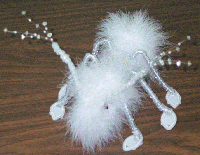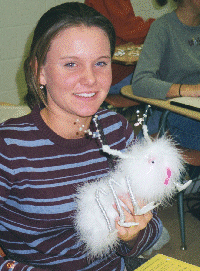I've got that Geometry Bug!
ON THE 8TH DAY.....
 And
on the 8th day, God created the Geometry BUG!! I first encountered
one of these fascinating creatures on June 18, 2000, which just so happened to
be my 16th birthday! This occurred when the bus dropped me off from
a long day of school. It seemed to be a 10-mile journey up and down the rolling
hills of crystal snow until I would reach my house. Let me tell you, this can
make a girl tired and thirsty, so I thought nothing better but to grab some
glistening snow from off the ground. After I patted it into a smooth snowball,
I went to take a bite out of it and then I heard something that shrieked,
"Hey man! Go and pick on somebody your own size!" I saw its light pink
eyes peering at me. Slowly the rest of its fluffy, white body slid out of the
slow. "Oh hey lil’ fella’! I’m sorry. I wasn’t planning on eating
you," I replied. Awww man was he so adorable. I guess I assumed it was a
bug of some sort, but it was so unique. "So, what exactly is your
name?" I inquired. "Oh well my name is Tri Alba Prism Fluff, but you
can call me Fluff," he said. "Glad to meet you. My name is Cassy,"
I said. And
on the 8th day, God created the Geometry BUG!! I first encountered
one of these fascinating creatures on June 18, 2000, which just so happened to
be my 16th birthday! This occurred when the bus dropped me off from
a long day of school. It seemed to be a 10-mile journey up and down the rolling
hills of crystal snow until I would reach my house. Let me tell you, this can
make a girl tired and thirsty, so I thought nothing better but to grab some
glistening snow from off the ground. After I patted it into a smooth snowball,
I went to take a bite out of it and then I heard something that shrieked,
"Hey man! Go and pick on somebody your own size!" I saw its light pink
eyes peering at me. Slowly the rest of its fluffy, white body slid out of the
slow. "Oh hey lil’ fella’! I’m sorry. I wasn’t planning on eating
you," I replied. Awww man was he so adorable. I guess I assumed it was a
bug of some sort, but it was so unique. "So, what exactly is your
name?" I inquired. "Oh well my name is Tri Alba Prism Fluff, but you
can call me Fluff," he said. "Glad to meet you. My name is Cassy,"
I said.
It
had to be 10 below 0! "Aren’t you cold; do you want me to make you some
soup?" I asked. But, after I asked the question I thought to myself,
"What a stupid question!" I could see that he was obviously a winter
bug because of its layers and length of white fur.
Fluff’s
white body was an ellipsoidal shaped hard outer shell. It was segmented into 3
parts: the head, thorax, and abdomen. The shape aids in balancing and weight
load. Covering the shell is a layer of white hair. This is a necessary thermal
protection so the bug can last through 6 months of snowfall and cold weather.
This white hair also camoflauges the bug in the snow to protect it from
predators like squirrels and deer from attacking it.
The
most amazing part of Fluff is its head. Its eyes consist of three layers of
intricate crystal like prism. A prism is a solid whose bases or ends have the
same size and shape and are parallel to one another, and each of whose sides
has two pairs of parallel edges. The first layer, which is the pink layer,
consists of triangle and pentagon shapes. The next layer, which is the clear
layer that is slightly smaller than the first, is a quadrilateral diamond
shape. The black layer, the smallest, is made up of a hexagon center surrounded
by trapezoids. A trapezoid is a 4-sided plane having 2 sides parallel and 2
sides not parallel. 
In
between the eyes are 2 antennas. They are covered with spiral layers of skin. A
spiral is a winding and gradually widening curve or coil. This gives the
antennas strength to withstand the weight of the snow. The receptors on the
antennas are very sensitive and are hexagon shaped prisms and spherical in
shape. A sphere is a round body whose surface has all points equally distant
from the center.
It’s
not every day that you see an insect with adorable eyelashes. These lashes
however, are not for appearances, but for protection. Any time it snows
heavily, which it does in the rolling hills of Minnesota, the lashes flutter to
protect the eyes from snow and other particles during storms and strong winds.
They are curved shaped. Curved lines are lines that have no straight parts,
which is a continuing bending line without angles, a line on which every point
can be defined by an equation à y= x
If
you have ever experienced your wet lips touching an ice cube you know how it
burns and sticks. Well, Fluff’s mouth is like a straw tube that works like a
vacuum, which helps to avoid such experiences. The outside of the tube is dry
and cylinder in shape. It can suck up snow and convert it into a liquid form.
The
Fluff bug’s diet consists of winterberries and nutmeats left over from the
squirrels during the fall months. Their favorite delicacies are dead insects
found under old logs and planter boxes.
There are special features that
aid the Fluff bug’s mobility. Its legs are multi-jointed right circular
cylinders. A cylinder is a solid bounded by 2 equal parallel circles and by a
curved surface, formed by moving a straight line of fixed length as that its
end always lie on the 2 parallel circles. In a right circular cylinder the
circles are perpendicular to the line. The multi joints help prevent injury,
and allow greater flexibility.
Fluff’s
feet are one of a kind in the insect world. They not only look like but also
act like snowshoes and are ellipsoidal in shape. An ellipsoidal is an oval
having both ends alike. It is a plane curve formed by the path of a point that
moves so that the sum of its distance from 2 fixed points (foci) remains the
same. They are edged with little rubber- like sphere shaped pads. The shape of
the feet is very important in the airo dynamics of going through snow. The pads
protect and add traction to prevent slipping on surfaces.
When
one would first glance at Fluff they might think of it to be a colorless white
fur. It only takes a little bit of light or sunshine to bring out the rainbow
of color from its 22 prisms!
The biggest challenge to the Fluff
bugs survival is its inability to climb trees and grasp due to the flat
snowshoe feet. But, boy can he run down hills of snow!
Project Description
Research Questions
Student Work
|